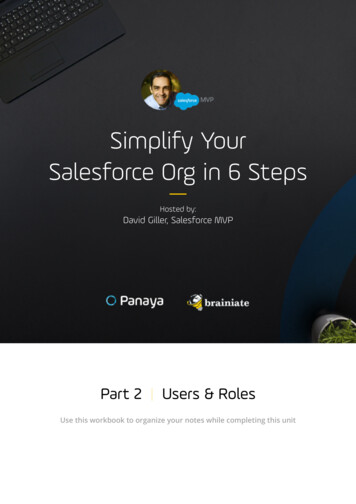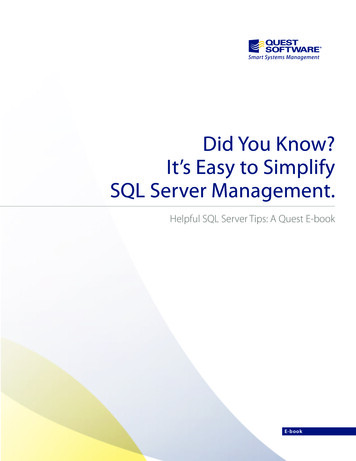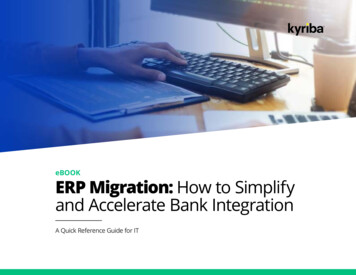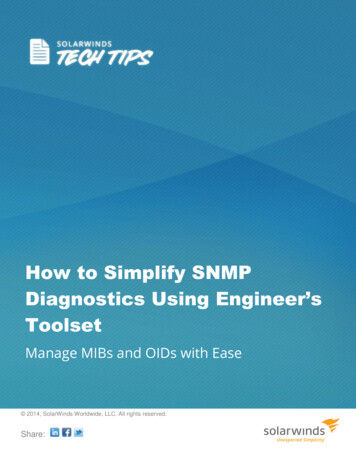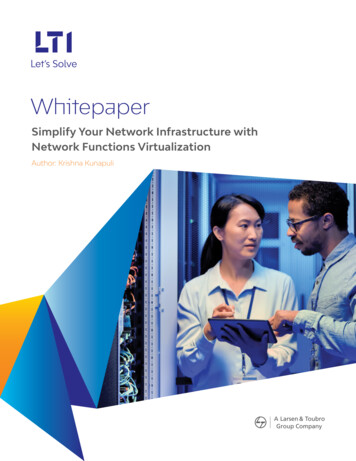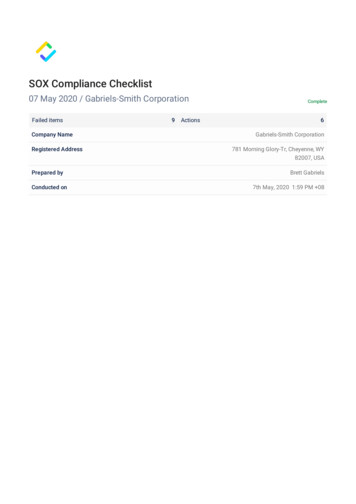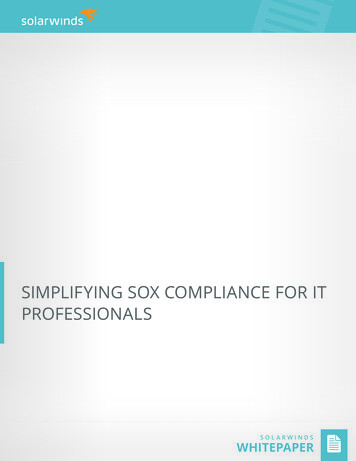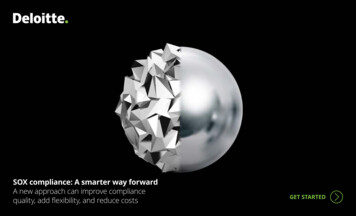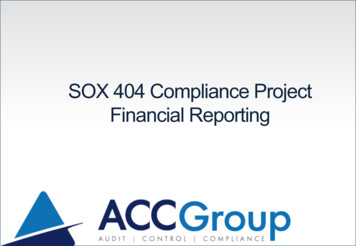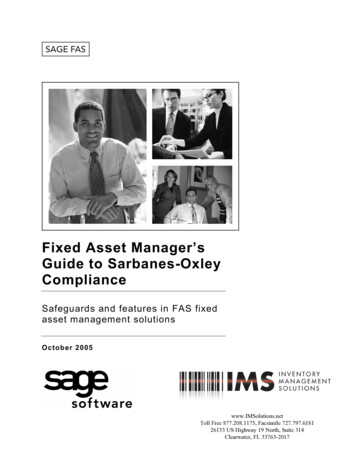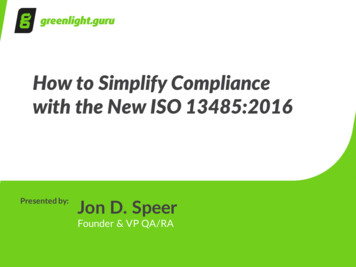
Transcription
How to Simplify Compliancewith the New ISO 13485:2016Presented by:Jon D. SpeerFounder & VP QA/RA
Today’s AgendaISO 13485 OverviewWhat has changed in the new ISO 13485:2016Why putting off compliance until later could cost youHow eQMS software can help simplify compliance5 Steps to take now to make for a smooth transitionQuestions
Who is Jon Speer 18 years in the medical device industry 40 products to market Speaker Thought leader and regular contributor at MedDevice Online, MedCity News, QMed, QualityDigest and other leading industry publications Expert in implementing quality systems Run one of the most popular blogs & the #1podcast in the medical device industry Founder and VP QA/RA greenlight.guru@creoquality @greenlightguruJon.Speer@greenlight.guru 1 317 960 4280
greenlight.guru – Quality Management Software The only eQMS solution designedexclusively for the unique needs of themedical device industry Designed by medical deviceprofessionals with decades ofexperience for medical deviceprofessionals Offer software services to enable youto comply with regulations andstandards like FDA 21 CFR Part 820 andISO 13485:2016 Customers & partners all over the globeon five continents“greenlight.guru has beeninstrumental for us moving soquickly through the ISOcertification and I wouldhighly recommend it.”
My Free Gift For You At The End – QMS Audit Checklist
My Goals For You Today1. You understand the major changes that are part of this revision ofISO 13485.2. You understand the benefit of not putting off compliance until thelast minute.3. You understand how leveraging market leading technology canhelp simplify your compliance.4. You have an actionable set of steps you can begin taking today atyour company to comply with the updated standard.
ISO 13485:2016A brief overview?
What is ISO 13485? The world- ‐wide sector Quality Management System (QMS)standard for medical device organizations Takes general quality system requirements for all organizationsintending to provide products or services to customers andmodifies it for application within the highly regulated medicaldevice industry An internationally agreed way to implement commonregulatory concepts (presumption of conformity) that supportmaximizing the potential benefits of making the strategicdecision to implement a quality management system?
Potential Benefits of ISO 13485 Enhances the ability of the organization to meetcustomer and regulatory requirements. Helps the organization’s capability to address productsafety and effectiveness. Allows the organization to obtain external recognitionof conformity of the quality management system toaccepted requirements (certification).
What ISO 13485 is NOT It is not a required structure for your QualityManagement System. It is not regulation—not the law. It does not define requirements for the productsand services provided by the organization. It does not define other business requirements orinitiatives (e.g. financial or environmentalrequirements).
Why did ISO 13485 need to change? The standard was due for revision based on the regular 5- ‐year cycle (secondedition released in 2003) First review (2008) determined no change needed. This review (2012/13) there were a couple of drivers. Requests from GHTF and AHWP User survey—generally pointed out the need for clarifications (implicit requirements) European Union lost faith in ISO 13485 as a way to obtain presumption of conformitywith the EU Medical Device Directive (issuance of EN ISO 13485:2012)
User Input—Clarity Enhance Clarity for Users – Manufacturer’s voice Survey of users found a desire for the standard to provide more clarity (implicitrequirement) Guidance exists in ISO TR 14969 but few individuals know this document exists (auditorinterpretation) Auditing (ambiguity) – Certification body’s voice Some clauses difficult to audit against Nonconformities could be written against different clauses MDSAP—Medical Device Single Audit Program
User Input—Global Harmonization Further Harmonization – Global voice GHTF Study Group 3 had published several guidance documents with additionalconcepts- ‐- ‐can these be incorporated and used with changes to the standard? More countries developing medical device regulations did not believe ISO 13485 couldmeet their needs Prevalence of importers & distributors in a few geographies Outsourcing of both m anufacturing (contract m anufacturing) and design (contract design) Organizations that only do part of the overall processEnhance compatibility with latest regulations and expectations
User Input—EU Challenges Standard not Robust Enough – EU Regulator Voice Due to scandals in EU with breast and hip implants the entire regulatory framework wasbeing challenged Determined that ISO 13485 alone and as written could NOT assure presumption ofconformity to the MDD’s “appropriate quality system” requirement More prescriptive requirements need to be included in the standard
Current ISO Timeline ISO 13485:2016 is published. WG1 has started work on a guidance handbook (approx. 1 year) The recommended 3 year transition accepted by TC 210 and IAF—no newcertifications/re- ‐certifications after year 2 Periodic review has been accelerated to March 2019
What has changed in the new ISO 13485:2016
Overview Integrates risk throughout the QMS and product life- ‐cycle—risk- ‐based decision- ‐making Move toward harmonization with US CFR, Brazilian law (ANVISA), CMDR(Canada), and other law (MDD, JPAL, TGA)—MDSAP Additional linkage to documentation required for regulatory purposes Integration of QMS software
Overview (cont.) Emphasis on appropriate infrastructure New references to other standards (usability, sterile barrier, etc.) New sections on complaint handling and reporting to regulatory authorities Clarity for auditing Planning and documenting corrective action (without undue delay) and preventiveaction
Annexes & Bibliography Annex A—comparison between 2003 & 2016 versions Annex B—correspondence of sections between ISO 9001:2015 and ISO13485:2016 Bibliography—the information provided helps locate documents referenced in thedefinitions and in the informational notes
List of Clauses Impacted 1 Scope 7.4.1 Purchasing process 3 Terms and definitions 7.4.2 Purchasing information 4 Quality management system 7.4.3 Verification of purchased product 4.1 General requirements 7.5.1 Control of production and service provision 4.2 Documentation requirements 7.5.2 Cleanliness of product 5.6 Management review 7.5.4 Servicing activities 6.2 Human resources 7.5.6 Validation of processes for production and service 6.3 Infrastructure 6.4 Work environment and contamination control 7.1 Planning of product realization 7.2 Customer- ‐related processes 7.5.8 Identification 7.3.2 Design and development planning 7.5.11 Preservation of product 7.3.3 Design and development inputs 8.2.1 Feedback 7.3.5 Design and development review 8.2.2 Complaint handling 7.3.6 Design and development verification 8.2.3 Reporting to regulatory authorities 7.3.7 Design and development validation 8.2.6 Monitoring and measurement of product 7.3.8 Design and development transfer 8.3 Control of nonconforming product 7.3.9 Control of design and development changes 8.4 Analysis of data 7.3.10 Design and development files 8.5.2 Corrective action 8.5.3 Preventive actionprovision 7.5.7 Particular requirements for validation of processesfor sterilization and sterile barrier systems
1 Scope Scope includes organizations that have a role in one or more stages of the ‘life- ‐cycle’ Identification of ‘outsourced’ processes Maintain exclusion for design control if permitted by regulatory requirements withnew option to “not apply” requirements of clauses 6, 7, and 8 (with justification)depending on organization’s role
3 Terms and Definitions Removed: Supply Chain explanation, Active Implantable Medical Device, ActiveMedical Device Modified: Complaint, Labeling, Implantable Medical Device, Medical Device andSterile Medical Device Added: Authorized Representative, Clinical Evaluation, Distributor, Importer, Life- ‐cycle, Manufacturer, Medical Device Family, Performance Evaluation, Post MarketSurveillance, Product (from 9000:2005), Purchased Product, Risk, RiskManagement, Sterile Barrier System and Sterile Medical Device
4 Quality Management System & 4.1 General Requirements Re- ‐organized this entire clause Redefined ‘document’ to mean: Establish, implement and maintain (as well asdocumenting) Must document organization’s role Establish risk- ‐based approach within processes—proportionate to the risk Maintain control of outsourced processes QMS software validation
7.3.2 Design and Development Planning Maintain (update) planning documents Reviews separated from verification/validation Add method to assure traceability (inputs/outputs) and resource planning(including competencies)
7.3.3 Design and Development Inputs Add usability (ref. to IEC 62366) Add ‘standards’ as an input Risk management moved up in list Added processes to other requirements Added ‘able to be verified or validated’
7.3.4 Design and Development Outputs In a form suitable for verification against design & development input Approved prior to product release
7.3.6 Design and Development Verification Planned & documented arrangements Plan includes: Method, acceptance criteria and statistical technique with rationalefor sample size Connection to other devices Report includes: Results (same) and conclusions (new)
7.3.7 Design and Development Validation Planned & documented arrangements Plan includes: Method, acceptance criteria and statistical technique with rationalefor sample size Connection to other devices Report includes: Results (same) and conclusions (new) Clinical/performance evaluation not released for use (from notes in the 2003version). Use of production units (representative product)/document equivalency (rationalefor choice of product) Clinical evaluation or performance evaluation in accordance with regulatoryrequirements.
7.3.8 Design and Development Transfer NEW SECTION Document procedures Verify design outputs are suitable for manufacturing Verify production specifications can meet product requirements
7.3.9 Control of Design and Development Changes Documentprocedures e,usability,safety®ulatoryrequirements
7.3.10 Design and Development File NEW SECTION
7.4.1 Purchasing Process, 7.4.2 Purchasing Information,& 7.4.3 Verification of Purchased Product Purchasing process controls—risk based Supplier evaluation & selection Supplier monitoring & re- ‐evaluation Supplier documentation CommunicationPurchasing information Addition of “requirements for qualification of supplier personnel” Notification of changes (written agreement)Verification of purchased product—risk based
Why Putting Off Compliance Until Later CouldCost You
Risk- ‐Based QMS ISO 14971 risk management approach serving as a foundation for QMS ALL QMS processes utilize risk- ‐based approach ALL QMS processes “feeding” into product risk management Risk- ‐Based QMS is about managing your business
Better Processes Opportunity for better integration across entire QMS Improved efficiency Better alignment with global regulatory bodies Medical devices that are safer and more effective
The Costs Do you want to wait until implementing ISO 13485:2016 becomes mandatoryfrom your registrar? Not integrating risk- ‐based approaches into your QMS QMS wrong- ‐size & complicated Out of sync with regulatory expectations and best practices Lack of competitive advantage
How eQMS Software Can Help SimplifyCompliance
stem*Must.And my system works so well because it does leverage the best People ;This is you and your amazing teamProcesses ; This is my S.M.A.R.T. 5 Phase QMS SystemTechnology***** , This*is*what*we’re*about*to*talk*about*
WHY portant.1. It’s'the'law.'2. k.'3. It'protects'the'patients.'4. An'audit'will'happen.'Will'you'be'ready?5. . 'nonEcompliance.
Traceability objective evidence everything
“If it wasn’t documented,it didn’t happen.”
But traceability and documentation take soo long.
And you’re not a high paid secretary.You need to focus on designing innovativedevices .not updating spreadsheets.
Realize this Paper- ‐based quality systems are notthe cheapest and easiest type ofQMS to implement.even if you’re an early stagecompany, with little to no funding,and a product still in R&D.
And the best, market leading companiesunderstand this
Here’s what going with a paper- ‐basedsystem will mean for your company.You will Have missing documents and records Documents and records will be out of sync Must have review and approval signature will be missingduring an audit
What you will experience using greenlight.guru Comply with all the latest regulations by leveragingtechnology with the latest best practices built in Easily manage and mitigate risk Improve your time to market by increasing efficiency andeffectiveness of processes Empower stakeholders with real time access to completeand accurate data Single Source of Truth
greenlight.guru vs. a paper- ‐based quality system Top 10 ways to save time using greenlight.guru vs. a paper- ‐based a approach 1. Documenting work6. Prioritizing work2. Reviewing documentation7. Linking / tracing related items3. Communicating with otherteam members8. Seeking approvals4. Performing data/projectanalysis5. Organizing work9. Providing objective evidence10. Establishing risk controlmeasures
Document Management & Control in greenlight.guru
Here are just a few more of the issues you’ll runinto using a paper- ‐based QMS. Limits traceability Hinders team based work Complicates design transfersbetween teams Error prone Way too slow to perform riskanalysis Very hard and time consumingto update or edit traceabilitymatrix Complicates risk management Lost or missing documentsduring an audit Provides zero value to thedevelopment of the product Getting signatures approvals isa hassle
Design Controls Risk Management in greenlight.guru
Problems with low power legacy solutions and battleship,enterprise solutions Complicated and hard to use Cost and time of implementation and maintenance are often notwell understood No team of medical device experts to walk you through every stepof the process Not specifically built for the medical device industry Not promptly and continuously updated to new industry standardslike ISO 13485:2016
Design Controls Risk Management in greenlight.guru
When you combine award- ‐winning technology likegreenlight.guru with industry best practices you get. Alignment with medical device industry regulations and requirements,including FDA 21 CFR Part 820, FDA 21 CFR Part 11, ISO 13485, and ISO14971 Workflows and best practices integrated to improve overall efficiency Intuitive user interface and usability Quick and easy implementation and training Technical and customer support to address medical device industry needs Expertise to ensure the eQMS solution continues to align with changingmedical device industry regulatory needs
Remember a Bulletproof Medical DeviceQuality Management System Must.Leverage the best 1. People2. Processes3. TechnologyYou’ve already got #1 covered. We can help you with #2 & #3.
5 Steps to Take Now to Make for a SmoothTransition
5 Key Steps1. Get a copy of ISO 13485:20162. Understand differences between ISO 13485:2003 & ISO 13485:2016 Annex A—comparison between 2003 & 2016 versions3. Conduct a gap analysis of existing QMS versus ISO 13485:2016 Get Your Free QMS Audit Checklist & Schedule Your Free 30 Minute QMSStrategy Session at http://www.greenlight.guru/qms- ‐audit- ‐checklist4. Contact your ISO registrar; determine their timeline for certifying to 2016 version5. Establish a Quality Plan Based on gap analysis registrar timeline
As Promised – Your Free QMS Audit ChecklistGo To: greenlight.guru/qms- ‐audit- ‐checklistto get your free QMS audit checklist & scheduleyour free 30 minute 1- ‐on- ‐1 QMS strategy session
ISO 13485:2016 – Key Takeaways Focus of this change is clarifications for use of the standard (implicit is nowexplicit) Basic changes to incorporate risk- ‐based decision making Set up to align documentation, clinical and other requirements with EU (MDD) Expansion of supplier controls and post- ‐market requirements in feedback Drive to Medical Device Single Audit Program (MDSAP) (FDA set to implement in2017)
Take Action! Appoint a team and project manager 5 Key Steps1. Get a copy of ISO 13485:20162. Understand differences between ISO 13485:2003 & ISO 13485:20163. Conduct a gap analysis of existing QMS versus ISO 13485:2016 http://www.greenlight.guru/qms- ‐audit- ‐checklist4. Contact your ISO registrar; determine their timeline for certifying to 2016version5. Establish a Quality Plan Prioritize efforts Establish a schedule Don’t wait . . . start now!
QuestionsWhat other concerns can we answer?Go To: greenlight.guru/qms- ‐audit- ‐checklistto get your free QMS audit checklist & scheduleyour free 30 minute 1- ‐on- ‐1 QMS strategy session
ISO(13485(Overview What(has(changed(in(the(new(ISO(13485:2016 you How(eQMS(software(can(help(simplify(compliance 5St
